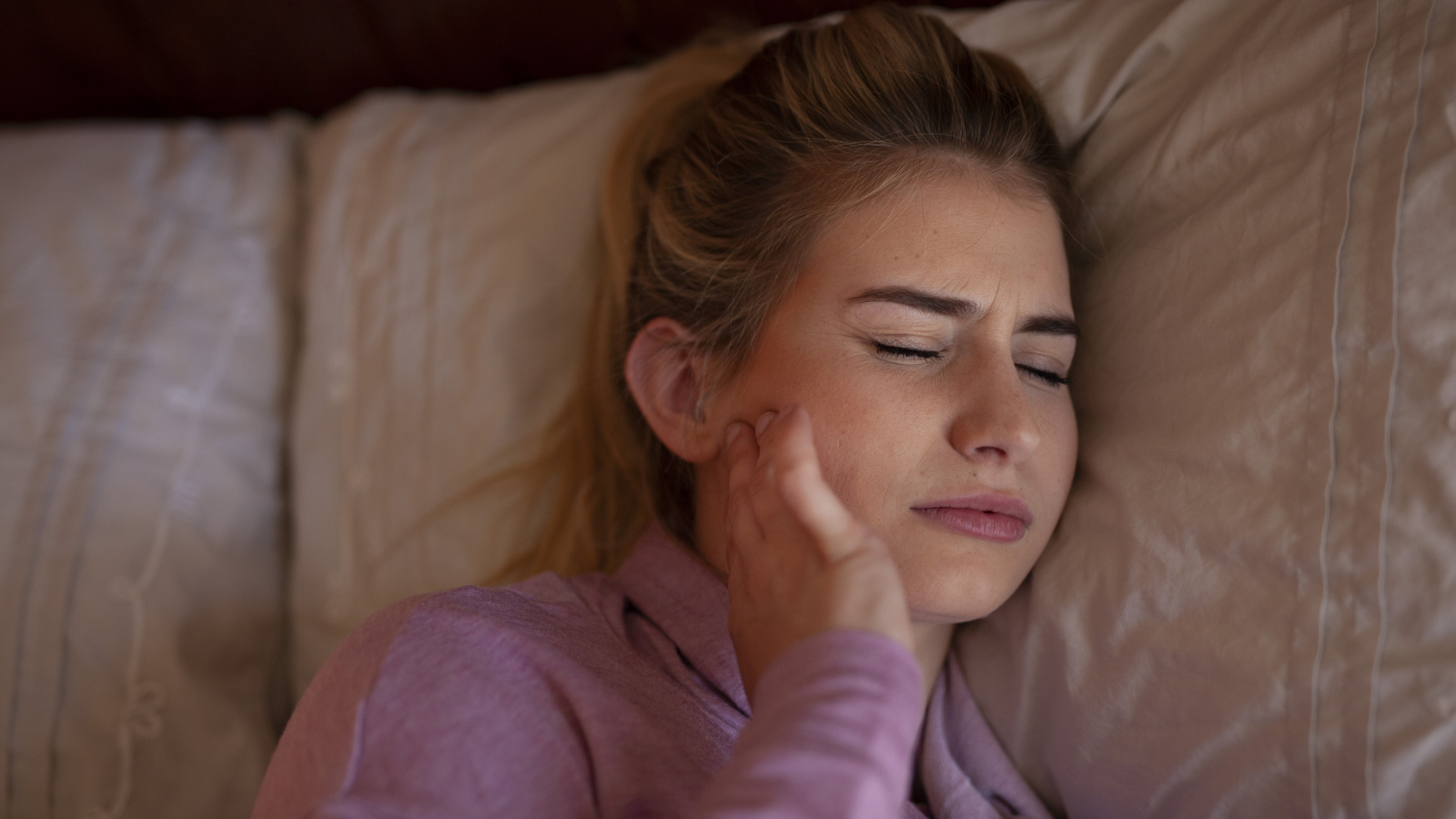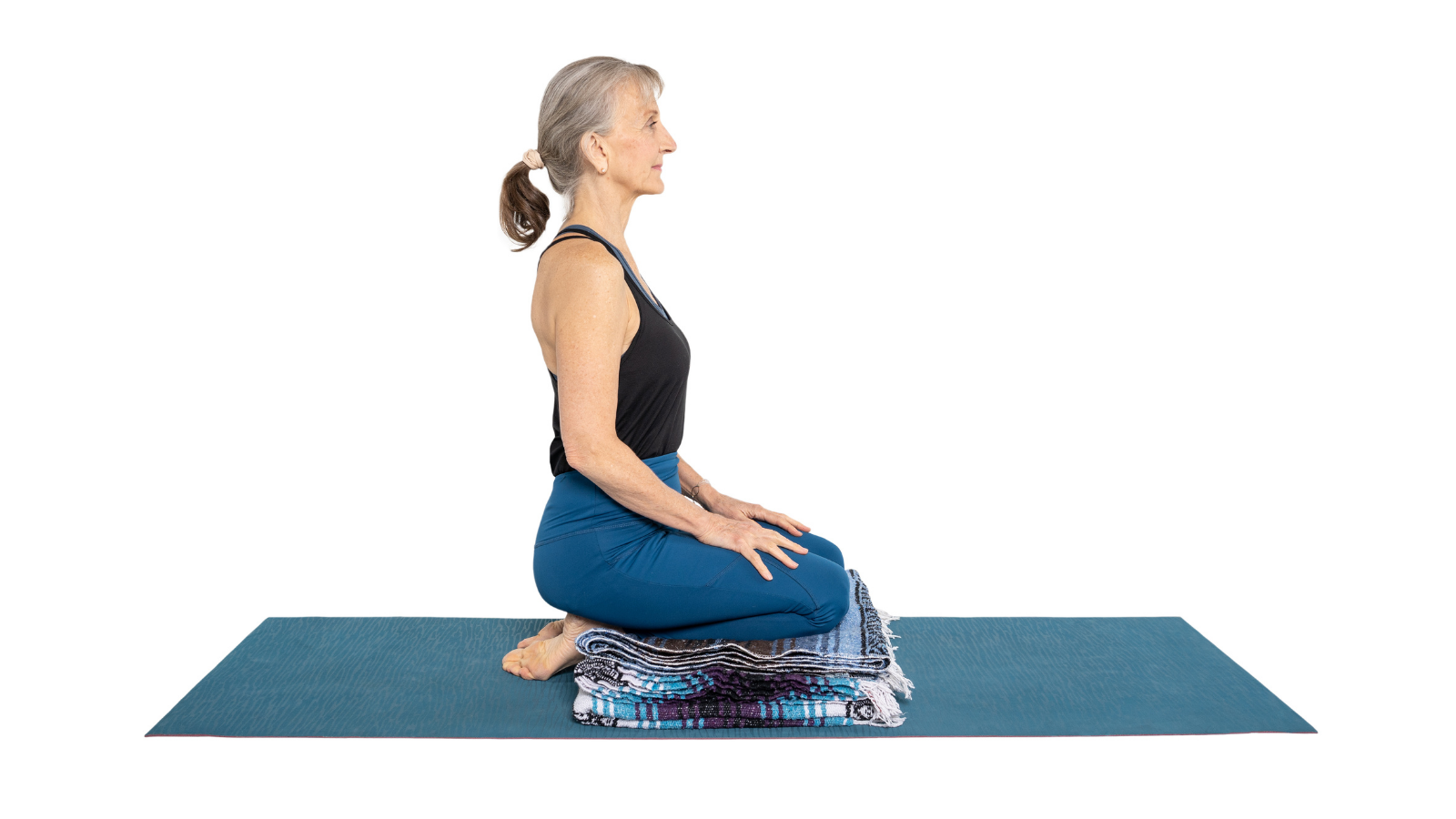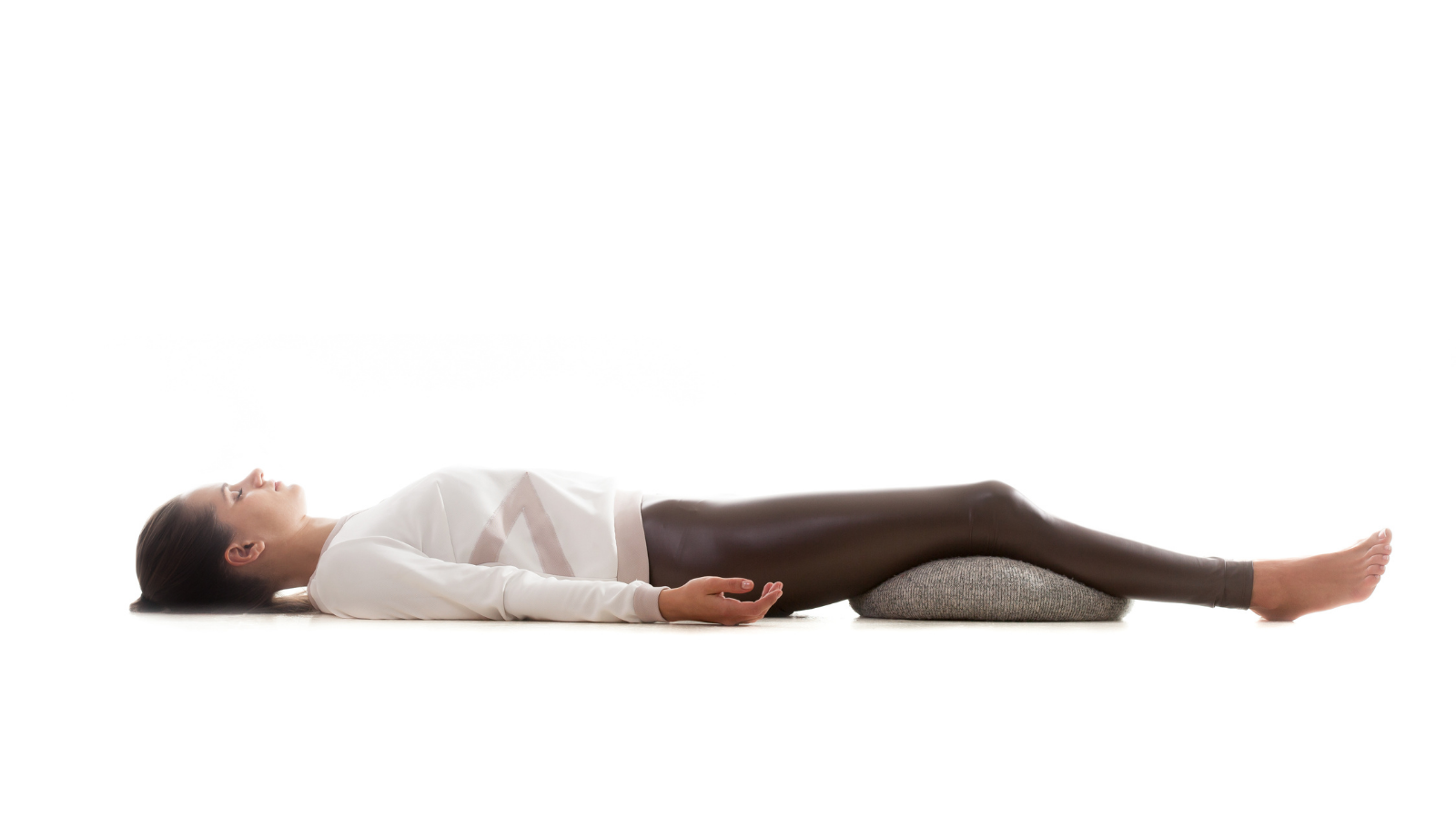TMJ Pain: What Does Research Say About Yoga as a Remedy?

Article At A Glance
When nighttime teeth grinding is the root cause of TMD, the path to healing can be frustrating. But the good news is that stress reduction and jaw exercises may help. Learn research on yoga for TMJ as well as the best yoga practices for TMJ pain here.
Why is TMJ so debilitating, and how can yoga help? As shocking as it may sound, grinding your teeth at night is like inviting a large football player to stand on your teeth, according to the director of the Tufts University School of Dental Medicine Craniofacial Pain Center in an article in The New York Times (1). As shocking as it may sound, our upper and lower teeth may be compressed by a force of around 250 pounds for 40 minutes per hour of the night during sleep bruxism, which is the medical name for grinding and gnashing of the teeth during sleep. This is a significant jump from the normal amount of pressure that a person’s teeth face from chewing, which is estimated to be between 20 to 40 pounds for about 20 minutes each day.
The bad news is that you may not even realize you’re grinding your teeth at night until its characteristic symptoms begin to occur during waking hours. These symptoms may include headaches, pain in the jaw or face, and loose or damaged teeth. The enamel in our teeth is 15 percent harder than bone, so bruxism has likely already been occurring for several years when damage to the teeth becomes apparent. Over time, bruxism can lead to more significant symptoms, such as chronic headaches or earaches, significant damage to the teeth, facial muscle enlargement, and chronic pain or disorders of the temporomandibular joint (TMJ).

Bruxism and TMJ Pain: What Are the Symptoms?
The TMJ, the joint where the temporal bone and jawbone meet, is one of the most complex joints in the body. A surprisingly sizable number of muscles in the face, the head, and the neck work in harmony to make the TMJ work smoothly. Thus, in individuals with TMJ pain and TMJ disorder (TMD, also commonly referred to as TMJ), it can be tricky to pinpoint which specific muscles to target to alleviate pain.
The most common symptom of TMD is chronic pain and stiffness in the jaw, but its symptoms can also spread to other regions in the head and face. Individuals with TMD often experience a dull ache in the side of the jaw while chewing that can radiate up the face, around the ear, and to the back of the neck. Other common symptoms of TMD include earaches, headaches, changes in how the teeth fit together, and clicking or popping noises when opening the jaw.
Teeth grinding isn’t always the cause of TMD. Osteoarthritis, rheumatoid arthritis, and dislocation of the jaw can also contribute to the disorder. However, researchers estimate that bruxism may be present in 78 percent of individuals with TMD. Thus, treating the two simultaneously may be worthwhile when the source of TMD is unknown.
Is it Possible to Stop Teeth Grinding?
When nighttime teeth grinding is the root cause of TMD, the path to healing can be frustrating. Sleep bruxism is governed by the unconscious mind and occurs when defense mechanisms that typically protect us from inflicting pain on ourselves are inhibited. Nonetheless, regardless of an individual’s root cause, researchers find that conservative treatments like stress management (e.g., through counseling), massage therapy, and strengthening and stretching exercises should be considered first-choice therapy for TMJ pain (2).
For example, Wieckiewicz and colleagues report that muscular therapy to correct the mobility of the jaw was found to be effective in 70 percent of TMD patients (2). These authors also report that massage therapy may be an effective technique to relieve swelling and pain around the TMJ. Massage therapy may help regardless of whether individuals have been diagnosed with bruxism or TMJ pain, as TMJ myofascial pain occurs in 31 to 76 percent of the population (2).
While little research has been done specifically on yoga for TMJ pain and bruxism, a review of bruxism by Murali and colleagues recommends yoga as a “reversible” treatment for bruxism (as opposed to surgery, which is considered permanent) (3). Additionally, in a pilot study, Vranceanu and colleagues found a relaxation response program (which combines education on how relaxation techniques can be used for pain in addition to cognitive-behavioral and resiliency-enhancing skills) to be efficacious for patients with chronic TMD (4).
Yoga for TMJ: How to Alleviate Pain from Teeth Grinding with Yoga Practice

While more research on yoga for TMJ pain and bruxism is needed, it is clear that stress reduction and jaw exercises may help. If you suffer from TMJ pain or want to stop grinding your teeth at night, try the following 20-minute sequence.
Seated Meditation for TMJ Pain
- Begin in Hero’s Pose (Virasana) seated on 1 to 3 blocks with your ankles hugging the edges of the blocks (shown above seated on blankets). Start to scan your body for tension, beginning with the base of your spine and working your way to the crown of your head. Notice if you can actively soften spaces that are holding stress.
- When you reach your jaw, notice if your teeth are touching. If they are, separate your teeth while touching the tip of your tongue to the roof of your mouth just in front of your top front teeth, similar to where it would be when vocalizing “N.”
- Once you’ve scanned your body up to the crown of your head, focus on softening your body as a whole. Continue with this focus for 5 minutes.
Jaw-Strengthening Exercises for TMJ Pain
When you first practice the following jaw-strengthening exercises, begin at a moderate intensity of effort and increase your intensity of effort after a few sessions.
- Stay in Virasana (or any other comfortable seat) to trace half the circles of your neck. As you draw your chin down to your chest, keep your jaw soft with your tongue touching the space behind your teeth, as in the seated meditation. As you gently roll your right ear toward your right shoulder, flex your left wrist as you open and close your jaw 15 times, creating a wide “O” shape with your mouth. After slowly drawing your chin back through the center, repeat this stretch on your left side.
- Next, interlace your hands behind your back (or hold onto a strap), lift your sternum, and draw your chin down toward your chest. Tuck your chin closer into your chest (as if trying to create a double chin) 15 times before releasing your interlace and gently lifting your head back to a neutral position.
- Finally, make a fist underneath your chin and use it as resistance as you open your jaw. Repeat this resisted opening 15-20 times.
Myofascial Release for the Jaw
Start gently as you practice the following self-massage techniques, and avoid applying too much pressure as doing so could increase tension in the face and neck instead of alleviating it.
- Take your hands to your scalp and use soothing, stroking, circular movements to massage the skin and underlying tissue. Continue these movements, working your hands down to your temples and across your brow line.
- As you reach the notch underneath your cheekbones about an inch away from your ears, you may come across additional sensations. You can apply the pressure of your fingertips to this trigger point for about 10 seconds.
- Work your hands to the back of your neck. Here, you may find another trigger point at the suboccipital ridge, located where the back of your skull meets your neck. You can also apply the pressure of your fingertips to this trigger point for about 10 seconds.
Relaxation Pose (Savasana) with a Cervical Bolster
- Set up for Savasana by rolling a blanket or hand towel into a thin bolster that fits the space behind the back of your neck. Your head should be in a neutral position as you lie on this bolster (if your chin is tucked into your chest or you’re gazing toward the back wall, the bolster is probably too big). This bolster can be used to support the back of your neck as you rest. Stay in Savasana for 10 minutes.

Conclusion: Yoga for TMJ Pain
TMJ pain and teeth grinding are two health issues that co-occur frequently. Although more research on yoga for TMJ pain is needed, including stress reduction techniques, jaw-strengthening exercises, and myofascial release techniques in your yoga practice may be worth exploring as a conservative treatment.
Also, read...
It’s Official: Text Neck Syndrome Is Now a Global Epidemic
Got Jaw Pain? 3 Yoga Strategies for Alleviating TMJ Discomfort
The Text Neck Syndrome: 3 Yoga Exercises to Help
Related courses
Keys to Finding Inner Strength: A Yogic Wisdom Path to Developing Greater Resilience
Somatic Yoga for Fascial Unwinding

Lacey Ramirez is a St. Louis-based ERYT-200 yoga teacher and a freelance writer. Through her teaching and writing, she seeks to make yoga accessible, inclusive, and equitable. Lacey has completed certifications in Prenatal Yoga and Barre as well as trauma-informed yoga trainings. Additionally, she holds a Masters of Science in Global Health and Population from Harvard T.H. Chan School of Public Health. To learn more and connect, visit her website laceyramirez.com
References
- Van De Carr, P. (2007) A lineman in my bed: Notes on teeth grinding. The New York Times. Retrieved from https://www.nytimes.com/2007/11/13/health/13grin.html
- Wieckiewicz, M., Boening, K., Wiland, P., Shiau, Y., & Paradoxska-Stolarz, A. (2015) Reported concepts for the treatment modalities and pain management of temporomandibular disorders. Journal of Headache Pain, 16, 106. Retrieved from https://www.ncbi.nlm.nih.gov/pmc/articles/PMC4671990/
- Murali, R. V., Rangarajan, P., & Mounissamy, A. (2015). Bruxism: Conceptual discussion and review. Journal of Pharmacological Bioallied Sciences, 7(Suppl 1), S265-S270. Retrieved from https://www.ncbi.nlm.nih.gov/pmc/articles/PMC4439689/
- Vranceanu, A., et al. (2013). The relaxation response resiliency enhancement program in the management of chronic refractory temporomandibular joint disorder: Results from a pilot study. Journal of Musculoskeletal Pain, 21(3), 224–230.Retrieved from https://www.ncbi.nlm.nih.gov/pmc/articles/PMC4641848/


